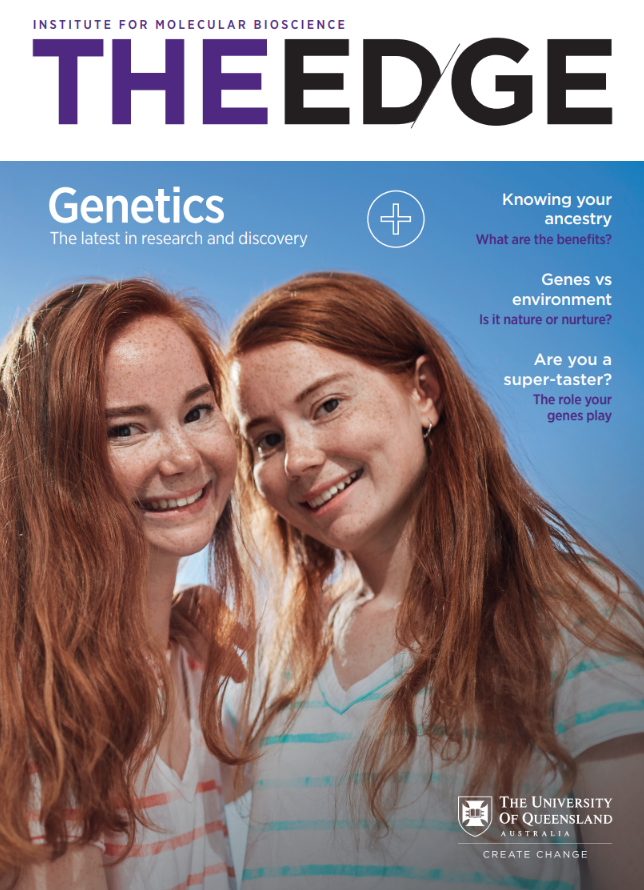
IMB's latest news, explainers and more
Risk of depression and heart disease linked in women
Get the latest research to your inbox
- Honorary Associate ProfessorInstitute for Molecular Bioscience
- Adjunct ProfessorInstitute for Molecular Bioscience
- Director, Institute OperationsInstitute for Molecular Bioscience
White group
Group Leader
Dr Mel White
Senior Research FellowInstitute for Molecular BioscienceResearcher profile is public:1Supervisor:Researcher biography:Dr Melanie White heads the Dynamics of Morphogenesis Lab at the Institute for Molecular Bioscience (IMB), University of Queensland and is an ARC Future Fellow. She completed a PhD in Neuroscience at University College London followed by postdoctoral research at The University of Edinburgh. During this time Mel engineered viruses to modulate gene expression in the brain to investigate neuronal function and as a therapeutic approach for neurodegenerative disease. Her work was published in Neuron and PNAS, featured in Nature Reviews Neuroscience and received extensive international media coverage (including the BBC and The Guardian).
In 2012 Mel switched fields to apply quantitative imaging in developmental biology. Her work revealed key mechanisms driving the earliest morphogenetic events in mammalian embryogenesis and was published in Cell, Science, Nature Cell Biology, Developmental Cell and Nature Protocols. Her research was featured on the cover of multiple journals including Cell and she was awarded the inaugural American Society for Cell Biology Porter Prize for Research Excellence (2018).
In 2020, Mel joined the IMB where she will combine her passion for neuroscience and developmental biology to investigate the dynamics of neural tube morphogenesis.
Research overview
The brain and the spinal cord control most of the functions of the body and the mind, yet the dynamics of how they first form is poorly understood. Both structures arise from a common precursor, the neural tube, which forms very early in embryonic development. To generate the forces that sculpt and shape the neural tube, changes in cellular architecture must be tightly coordinated in space and time. These morphological rearrangements occur concurrently with biochemical signalling pathways that specify early neural cell fates.
Our research aims to understand how cellular properties and transcriptional regulators interact with mechanical forces in real time to direct vertebrate neural tube formation and neural cell fate specification. We study the dynamics of neural tube formation by applying advanced imaging technologies in transgenic avian models and human stem cell models.
Body:Highlights
The use of high-spatiotemporal resolution live imaging has enabled us to discover and characterize new cellular structures essential for early embryo development. Firstly, we revealed the existence of long filopodia that form in some cells of the preimplantation mouse embryo and stretch out over their neighbors to facilitate the crucial process of embryo compaction (Nature Cell Biology, 2013). I also contributed to work characterizing a non-centrosomal microtubule organising centre that directs intracellular transport of adhesion molecules in the embryo (Science, 2017). Most recently, I discovered rings of actin filaments that form on apical cell surfaces of the mouse embryo and expand to the cell junctions just prior to blastocyst formation (Cell, 2018). We showed that coupling of these rings to the junctions triggers a tension-dependent zippering process that seals the embryo and allows expansion of the first cavity.
The development of an embryo requires a series of cell fate decisions to produce all the future cells of the body and extraembryonic tissues. Deciphering the mechanisms controlling cell fate determination is important not only to understand embryonic development, but also to provide advances in stem cell reprograming and regenerative medicine. My research has provided important insights into when and how cell fate bias first arises in the embryo and the mechanisms that drive the physical separation of the first cell lineages. By applying fluorescence correlation spectroscopy in the living embryo, we measured the binding dynamics of fate-specifying transcription factors (TF) in individual cells and revealed how differences in histone methylation affect TF dynamics to bias cell fate (Cell, 2016). Using 4D cell segmentation and computational tracking and laser-based ablations, we demonstrated that subcellular heterogeneities in tensile forces drive the first spatial segregation of cells in the embryo (Developmental Cell, 2015).
Connect





Researchers
Dr Yanina Alvarez
Research Fellow/Senior Research officerInstitute for Molecular BioscienceResearcher profile is public:1Supervisor:Dr Yi-Cheng Chang
Postdoctoral Research FellowInstitute for Molecular BioscienceResearcher profile is public:1Supervisor:Mr Jianxiong Wang
Casual Research Assistant & Postdoctoral Research FellowInstitute for Molecular BioscienceResearcher profile is public:0Supervisor:Miss Murron Carroll
Casual Senior Research AssistantInstitute for Molecular BioscienceResearcher profile is public:0Supervisor:PhD Students
Mrs Marise van der Spuy
PhD StudentInstitute for Molecular BioscienceResearcher profile is public:0Supervisor:Ms Amber Driessen
PhD StudentInstitute for Molecular BioscienceResearcher profile is public:0Supervisor:Miss Samara Ranie
PhD StudentInstitute for Molecular BioscienceResearcher profile is public:0Supervisor:Mr Marius Predel
PhD StudentInstitute for Molecular BioscienceResearcher profile is public:1Supervisor:- 21 Feb 2025–22 Feb 2025Following previous meetings in 2017 (Garvan Institute) and 2022 (WEHI), the 3rd Autoinflammatory Disease Symposium will be combined with an Education Summit on Paediatric Rheumatology, in partnership with Zoe’s Angels, a non-profit organisation established to help benefit the lives of children diagnosed with juvenile rheumatic and musculoskeletal conditions.
- Postdoctoral Research FellowInstitute for Molecular Bioscience
Vetter Group
Group Leader
Professor Irina Vetter
NHMRC Leadership Fellow - Group LeaderInstitute for Molecular BioscienceResearcher profile is public:1Supervisor:Researcher biography:I am an NHMRC Leadership Fellow with joint apointments at the Institute for Molecular Bioscience (IMB) and School of Pharmacy, UQ. My research interests lie in the fields of peripheral pain mechanisms, target identification and analgesic drug discovery. I investigate the contribution of ion channels to sensory neuronal physiology using highly subtype-selective toxins isolated from venomous animals with the aim to develop novel analgesics with improved efficacy and tolerability.
Body:Highlights
Associate Professor Irina Vetter has a strong background in neuropharmacology, pain models, toxinology and high-throughput screening. Currently her primary research interests lie in the fields of peripheral pain mechanisms, target identification, biodiscovery of venom peptide ion channel modulators and analgesic drug discovery.
Associate Professor Vetter has always been fascinated by how we perceive the world around us, in particular, the role of sensory neurons in the body. Sensory neurons are an intricate network of nerve cells that convert external stimuli from the environment into messages within the body, like pain. Her research is demystifying the different pathways that contribute to pain in various disease states. She is using biomedical research and pharmacology to develop pain treatments from venoms and toxins.
Associate Professor Vetter is an ARC Future Fellow and Deputy Director of the Centre for Pain Research at The University of Queensland. She is a registered pharmacist and has worked in hospital as well as community pharmacy. She obtained her PhD in 2007 from the School of Pharmacy, and conducted postdoctoral studies as an NHMRC postdoctoral fellow under Prof Geoffrey Goodhill at the Queensland Brain Institute and under Prof Richard J Lewis at the Institute for Molecular Bioscience in the areas of axon guidance and venom peptide pharmacology
Video
Connect




Researchers
Dr Jennifer Deuis
ARC DECRAInstitute for Molecular BioscienceResearcher profile is public:1Supervisor:Researcher biography:My main research focus has been applying venom peptide pharmacology to pain pathway characterisation. This approach has led to the identification of novel pain mechanisms underlying the development of chemotherapy-induced pain, ciguatera, and burn-induced pain. In an addition, I have identified and characterised over 20 novel bioactive peptides, which includes a novel class of Nav1.7 inhibitors that is currently undergoing pre-clinical development as analgesics, and a novel class of stinging nettle toxins that act on a previously unidentified Nav1.7 interacting protein named TMEM233.
Dr Angelo Keramidas
Senior Research FellowInstitute for Molecular BioscienceResearcher profile is public:1Supervisor:Researcher biography:I am interested in ion channels in health and disease. Improved technologies for genetic screening is revealing an expanding catalogue of genetic variants to ion channels that give rise neurological disorders, such as epilespy syndromes, autism spectrum disorder and other neurodevelopmental disorders. My main research focus is on neurotransmitter-activated receptor ion channels that are found at neuronal synapses. These include GABA-A, glycine and glutamate (NMDA) receptors. I also work on other ion channesl such as voltage-gated sodium channels and synaptic receptors expressed in invertebrate nervous systems.
I am an expert at recording single ion channel, synaptic and conventional whole-cell currents for functional and pharmacological analyisis.
I collaborate with biophysicists, molecular biologists, geneticists, electrophysiologists and clinicians that specialise in genetic neurological disorders. I have active projects in collaboration with research groups in Australia, USA and Europe.
Ms Asa Andersson
Research AssistantInstitute for Molecular BioscienceResearcher profile is public:0Supervisor:Dr Hana Starobova
Higher degree by research (PhD) student & NHMRC Emerging Leadership FellowInstitute for Molecular BioscienceResearcher profile is public:1Supervisor:Researcher biography:Dr Hana Starobova is a pharmacist and NHMRC research fellow at the Sensory Neuropharmacology Group at the University of Queensland (UQ). She works under the mentorship of Prof. Vetter, and as an early career researcher, she is working toward an independent research career as a group leader. She obtained her PhD in 2020 from the Institute for Molecular Bioscience, UQ, and continued here to conduct studies as a Children Hospital Foundation Fellow (2021-2023) in the areas of cancer therapy-induced adverse and late effects with the main focus on neuropathies. Over the past four years, she has developed a research program focusing on the understanding of cancer therapy-induced adverse and late effects with a special interest in children, and established innovative transcriptomic and microscopy pipelines, in vitro assays, adult and juvenile models of adverse and late effects following mono- and combination chemotherapy and radiotherapy, assays for the assessment of adverse effects including cognition and neuropathies, as well as cancer models. Knowledge impact arising from her research program has been disseminated in 18 peer-reviewed publications, having together attracted >1,100 citations (h-index 15, i10-index 18, Google Scholar, May 2024).
Mr Theo Crawford
Visiting ResearcherInstitute for Molecular BioscienceResearcher profile is public:0Supervisor:Dr Vanessa Schendel
Postdoctoral Research FellowInstitute for Molecular BioscienceResearcher profile is public:1Supervisor:Mr Ben Cristofori-Armstrong
Higher degree by research (PhD) studentResearcher profile is public:0Supervisor:Ms Thi Ngoc Hue Tran
Researcher profile is public:1Supervisor:Students
Ms Wanlin Chen
Researcher profile is public:0Supervisor:Ms Naiqi Shi
Researcher profile is public:0Supervisor:Mr Ammar Alshammari
PhD studentInstitute for Molecular BioscienceResearcher profile is public:1Supervisor:Miss Priyaa Purushotham Vasan
Researcher profile is public:1Supervisor:Ms Svetlana Shatunova
PhD studentInstitute for Molecular BioscienceResearcher profile is public:1Supervisor:Miss Nicolette Tay
PhD studentInstitute for Molecular BioscienceResearcher profile is public:1Supervisor:Ms Ashvriya Thapa
PhD studentInstitute for Molecular BioscienceResearcher profile is public:1Supervisor:Ms Lucinda Walker
Global Challenges ScholarInstitute for Molecular BioscienceResearcher profile is public:0Supervisor:- Our research aims to understand the molecular mechanisms behind pain
Pages
Strawberry DNA extraction activity
Extract and view DNA from a strawberry using common household ingredients.
Get started
The Edge: Genetics
People have known for thousands of years that parents pass traits to their children, but it is only relatively recently that our technology has caught up to our curiosity, enabling us to delve into the mystery of how this inheritance occurs, and the implications for predicting, preventing and treating disease.
Subscribe to our newsletter
Get the latest research straight to your inbox.
Stay up-to-date as we answer questions about hot topics, and share the latest news at IMB, Australia’s #1 research institute.
General enquiries
+61 7 3346 2222
imb@imb.uq.edu.au
Media enquiries
IMB fully supports UQ's Reconciliation Action Plan and is implementing actions within our institute.
Support us
Donate to research
100% of donations go to the cause


